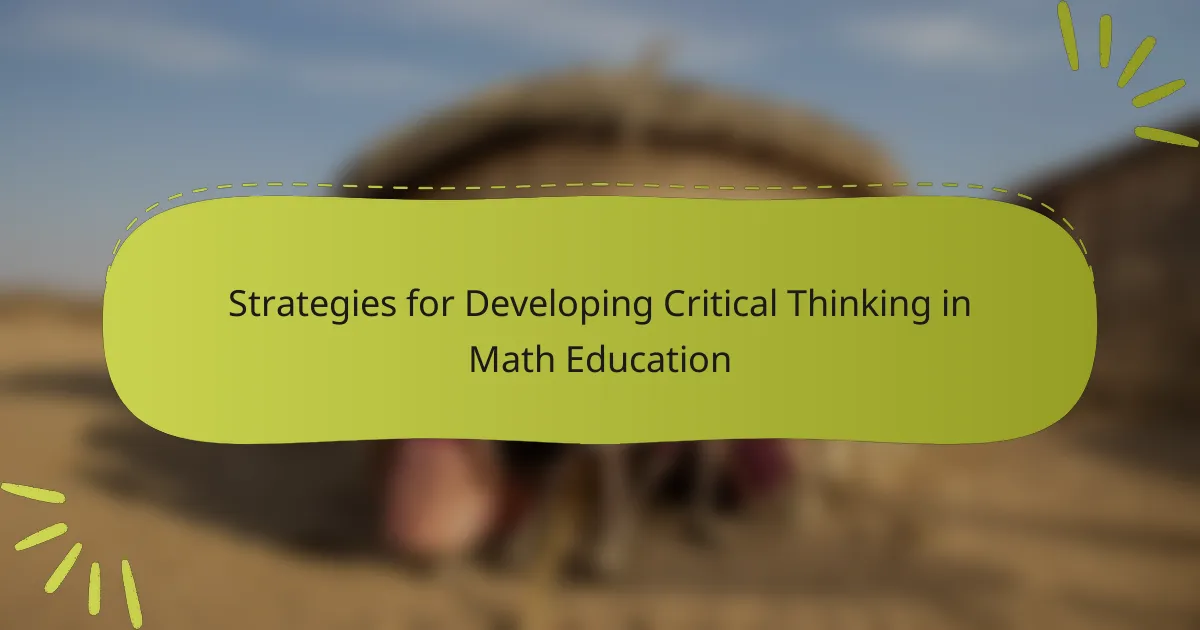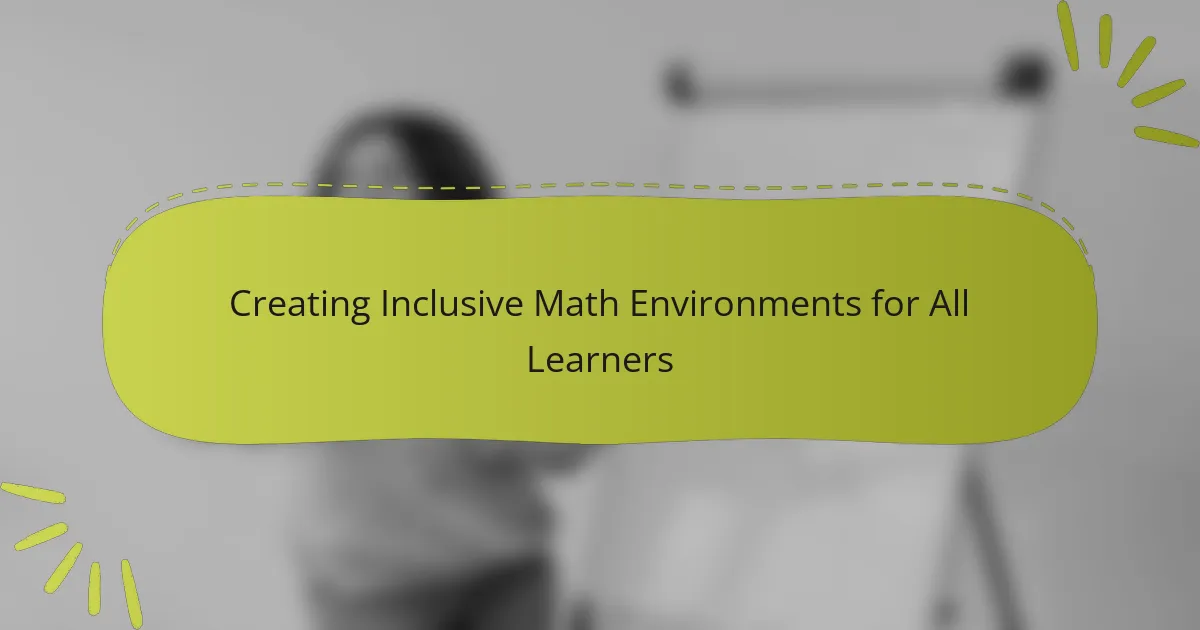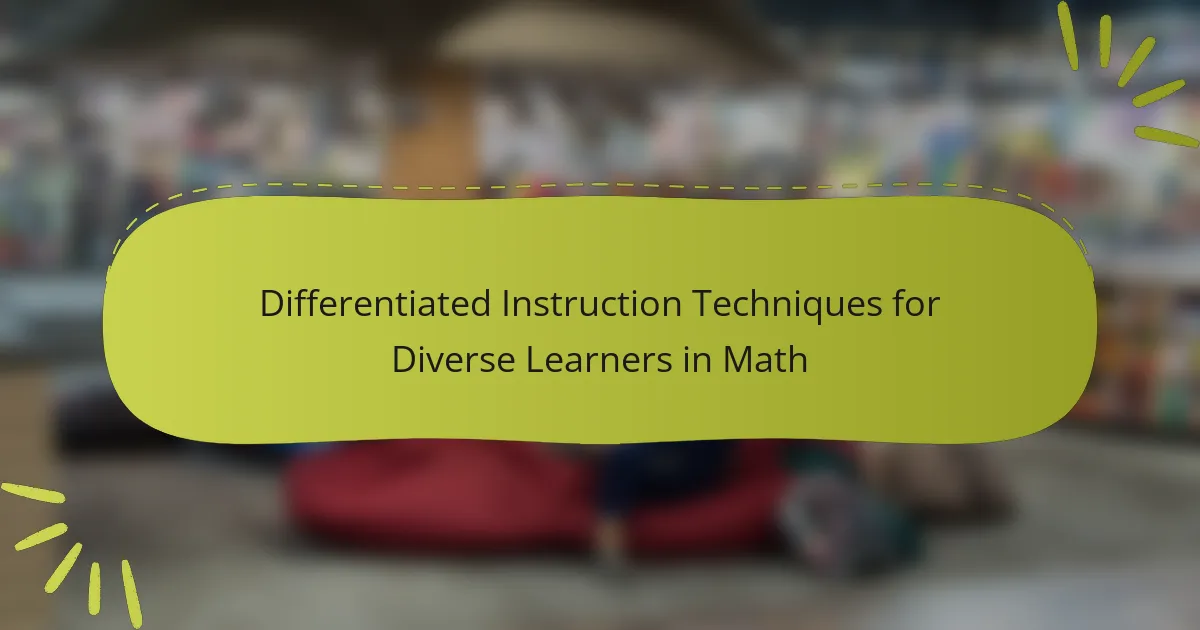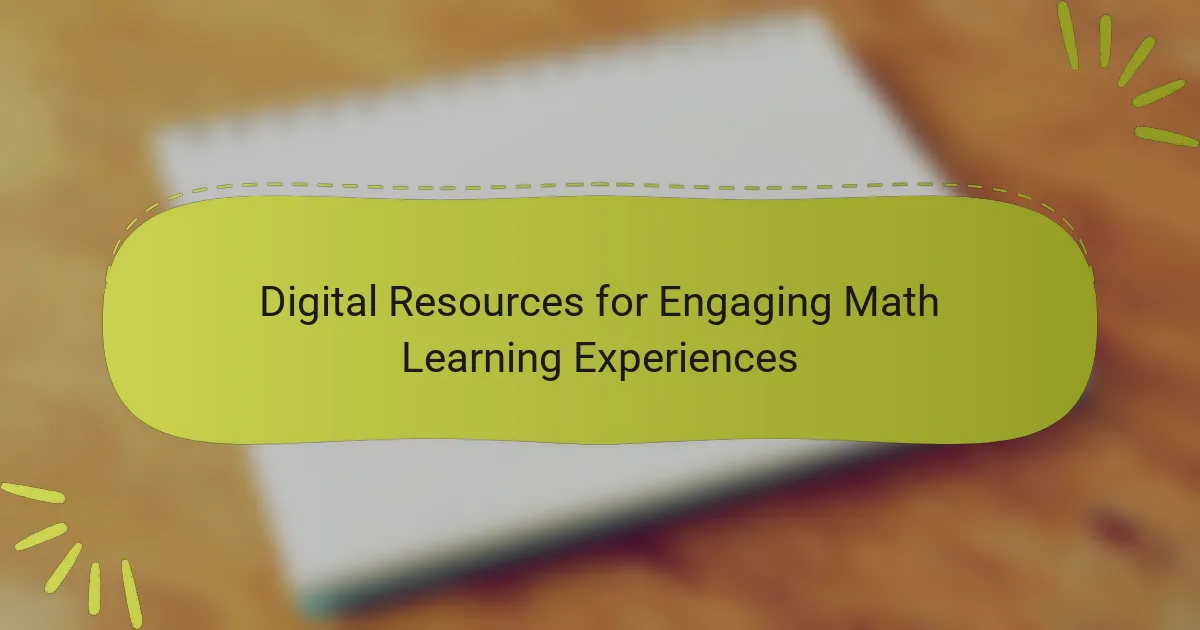Assessment strategies for measuring math proficiency in students encompass formative, summative, and diagnostic assessments. Formative assessments provide ongoing feedback during instruction, while summative assessments evaluate learning at the end of a period, and diagnostic assessments identify students’ strengths and weaknesses prior to instruction. Effective assessment strategies align with learning objectives and utilize a variety of methods to enhance understanding and retention of mathematical concepts. Best practices include regular review of assessment methods, timely feedback, and the involvement of students in self-assessment. Future trends indicate a shift towards technology integration, adaptive assessments, and a focus on problem-solving and critical thinking skills.
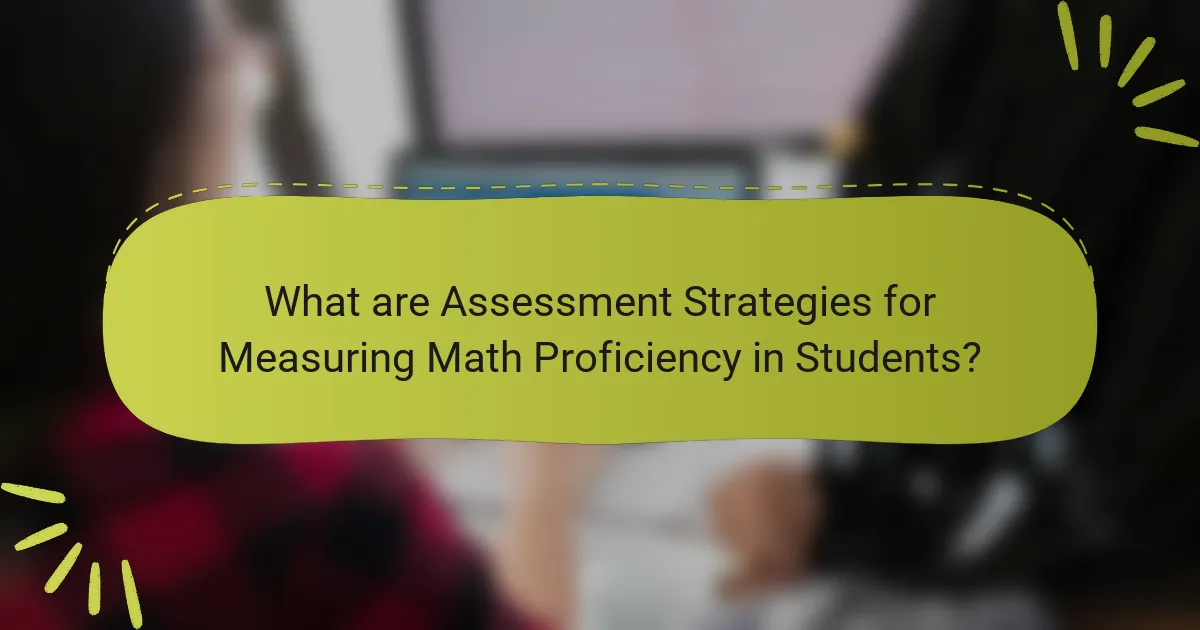
What are Assessment Strategies for Measuring Math Proficiency in Students?
Assessment strategies for measuring math proficiency in students include formative assessments, summative assessments, and diagnostic assessments. Formative assessments occur during instruction and provide ongoing feedback. Examples include quizzes, class activities, and observations. Summative assessments evaluate student learning at the end of an instructional period. Standardized tests and final exams are common summative assessments. Diagnostic assessments identify students’ strengths and weaknesses before instruction begins. Pre-tests and skill assessments are examples of diagnostic tools. Effective assessment strategies align with learning objectives and standards. They help educators make data-driven decisions to improve instruction. Research shows that varied assessment methods enhance understanding and retention of mathematical concepts.
Why is it important to assess math proficiency in students?
Assessing math proficiency in students is crucial for identifying their understanding and skills in mathematics. It allows educators to tailor instruction to meet individual learning needs. Regular assessments provide data on student progress over time. This data helps in recognizing areas where students struggle. Identifying these gaps is essential for developing targeted interventions. Furthermore, math proficiency assessments inform curriculum development and teaching strategies. They ensure that educational standards are being met. Research indicates that students who are regularly assessed in math perform better academically. For instance, a study by the National Center for Education Statistics found that students with frequent math assessments show higher achievement levels.
What implications does math proficiency have on student learning outcomes?
Math proficiency significantly impacts student learning outcomes. Students with strong math skills tend to achieve higher academic performance. Research shows that math proficiency correlates with improved problem-solving abilities. It also enhances critical thinking skills among students. A study by the National Assessment of Educational Progress found that students proficient in math score higher in other subjects as well. Additionally, math proficiency fosters confidence in academic pursuits. Students who excel in math are more likely to pursue advanced studies in STEM fields. This trend indicates that early math proficiency can shape future career paths and opportunities.
How does math proficiency influence future academic success?
Math proficiency significantly influences future academic success. Students with strong math skills tend to perform better in various subjects. Research indicates that math proficiency correlates with higher scores on standardized tests. For example, a study by the National Assessment of Educational Progress found that students proficient in math are more likely to excel in science and reading as well. Additionally, math skills are essential for pursuing higher education in STEM fields. Students lacking math proficiency may face challenges in advanced coursework. These challenges can lead to lower overall academic achievement. Thus, math proficiency serves as a foundational skill that supports a range of academic pursuits.
What types of assessment strategies are commonly used?
Commonly used assessment strategies include formative assessments, summative assessments, diagnostic assessments, and performance assessments. Formative assessments provide ongoing feedback during the learning process. Examples include quizzes, observations, and discussions. Summative assessments evaluate student learning at the end of an instructional unit. Standardized tests and final exams are typical examples. Diagnostic assessments identify students’ strengths and weaknesses before instruction begins. These may include pre-tests or skill inventories. Performance assessments require students to demonstrate their knowledge through practical tasks. Projects and presentations are common forms of performance assessments. Each strategy serves a unique purpose in measuring math proficiency effectively.
What are formative assessments and how do they contribute to measuring math proficiency?
Formative assessments are tools used to evaluate student learning during the instructional process. They provide ongoing feedback to both teachers and students. This feedback helps identify areas where students struggle. Teachers can adjust their teaching strategies based on this information. Formative assessments include quizzes, discussions, and observations. These methods allow for real-time insights into student understanding. Research shows that formative assessments can significantly improve student performance in math. For instance, a study by Black and Wiliam (1998) found that formative assessment practices lead to higher student achievement.
How do summative assessments differ from formative assessments in evaluating math skills?
Summative assessments evaluate math skills through final evaluations, while formative assessments monitor progress during the learning process. Summative assessments occur at the end of an instructional period. They typically include tests, projects, or standardized assessments. The results provide a summary of student learning and achievement. For example, a final exam in a math course assesses overall understanding of the material.
In contrast, formative assessments are ongoing and occur throughout the learning process. They include quizzes, class discussions, and homework assignments. These assessments help identify areas where students struggle and allow for timely feedback. For instance, a teacher may use a quiz to gauge understanding of a specific math concept before moving on to the next topic.
Research shows that formative assessments can significantly enhance student learning outcomes. According to a study by Black and Wiliam (1998), formative assessment practices lead to improved student performance. Summative assessments, while crucial for final evaluations, do not provide the same level of feedback for ongoing improvement.
What role do standardized tests play in assessing math proficiency?
Standardized tests serve as a primary tool for assessing math proficiency. They provide a uniform measure to evaluate students’ mathematical understanding and skills. These tests typically cover a range of math topics, including arithmetic, algebra, and geometry. By using a common set of questions, standardized tests facilitate comparisons across different student populations and educational systems. Research indicates that standardized test scores can correlate with students’ future academic performance in math-related courses. For example, the National Assessment of Educational Progress (NAEP) reports provide insights into national math proficiency levels among students. These assessments help educators identify areas needing improvement and inform curriculum development.
How can technology enhance assessment strategies for math proficiency?
Technology can enhance assessment strategies for math proficiency by providing personalized learning experiences. Adaptive learning platforms adjust difficulty based on individual student performance. This ensures that assessments are tailored to each learner’s needs. Additionally, technology facilitates instant feedback, allowing students to understand their mistakes immediately. Online assessments can analyze data to identify common areas of struggle among students. This data-driven approach enables educators to refine their teaching strategies. Furthermore, interactive tools such as math games engage students and make learning enjoyable. Research indicates that technology integration in math assessment can lead to improved student outcomes. For example, a study by the National Education Technology Plan found that technology use in classrooms enhances student engagement and achievement in mathematics.
What are some digital tools available for assessing math skills?
Digital tools available for assessing math skills include platforms like Khan Academy, IXL, and Prodigy. Khan Academy offers practice exercises and instructional videos tailored to various math topics. IXL provides personalized practice and immediate feedback on performance. Prodigy engages students through a game-based learning environment that adapts to their skill level. Other tools include Mathletics, which offers interactive activities and assessments, and Google Forms, which can be customized for quizzes and tests. These tools are widely used in educational settings to evaluate and enhance students’ math proficiency.
How can data analytics improve understanding of student math proficiency?
Data analytics can enhance the understanding of student math proficiency by providing insights into performance trends. It allows educators to analyze test scores and identify areas where students struggle. For instance, data can reveal common misconceptions in specific math topics. This targeted analysis helps in tailoring instruction to meet student needs. Additionally, analytics can track progress over time, highlighting improvements or declines in proficiency. Studies show that schools using data analytics see a 10-20% increase in student performance. By leveraging these insights, educators can implement effective interventions and support systems.
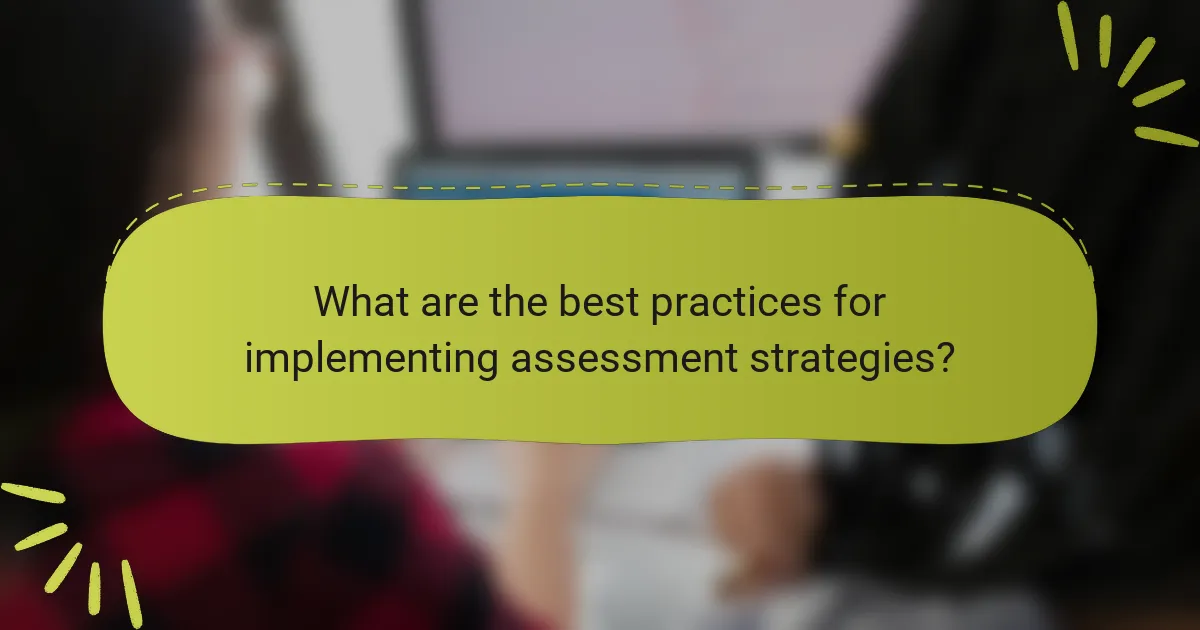
What are the best practices for implementing assessment strategies?
Best practices for implementing assessment strategies include aligning assessments with learning objectives. This ensures that assessments accurately measure what students are expected to learn. Regularly reviewing and refining assessment methods is crucial. This helps to adapt to changing educational standards and student needs. Incorporating a variety of assessment types enhances validity. This includes formative assessments, summative assessments, and performance-based tasks. Providing timely and constructive feedback is essential. Research shows that feedback improves student learning outcomes. Involving students in self-assessment promotes ownership of their learning. Studies indicate that self-assessment can increase student engagement and motivation. Finally, using data from assessments to inform instruction is vital. Data-driven decision-making leads to improved teaching strategies and student performance.
How can teachers effectively use assessment data to inform instruction?
Teachers can effectively use assessment data to inform instruction by analyzing student performance trends. This analysis helps identify areas where students struggle. Teachers can then tailor their lessons to address these specific needs. For example, if data shows low scores in geometry, teachers can introduce targeted activities. Formative assessments can be used regularly to gauge understanding. Summative assessments provide a broader view of student progress over time. Teachers should also collaborate with colleagues to share insights from data. This collaborative approach enhances instructional strategies across the curriculum. Research indicates that data-driven instruction leads to improved student outcomes. According to the Institute of Education Sciences, using data effectively can boost student achievement by up to 30%.
What strategies can be employed to differentiate instruction based on assessment results?
Differentiating instruction based on assessment results can be achieved through several strategies. One effective strategy is to group students by their assessment performance. This allows for targeted instruction that addresses specific skill gaps. Another strategy is to provide tiered assignments. These assignments offer varying levels of difficulty to meet diverse learning needs.
Additionally, using formative assessments can guide instructional adjustments. These assessments provide ongoing feedback that informs teaching methods. Incorporating flexible learning paths is also beneficial. This approach allows students to choose activities that align with their interests and proficiency levels.
Utilizing technology can enhance differentiation. Digital tools can offer personalized learning experiences based on assessment data. Finally, regular check-ins with students can help monitor progress and adjust strategies as needed. These methods collectively support tailored instruction that meets individual student needs.
How can feedback be provided to students to enhance their math skills?
Feedback can be provided to students through timely, specific, and constructive comments on their work. This approach helps students understand their strengths and areas for improvement. Immediate feedback reinforces learning and corrects misunderstandings. For example, providing solutions and explanations for incorrect answers clarifies misconceptions. Additionally, using rubrics can guide students on how to achieve higher scores. Peer feedback also encourages collaboration and deeper understanding. Research shows that effective feedback can improve student performance by 30%. This indicates that structured feedback is crucial for enhancing math skills.
What challenges do educators face in assessing math proficiency?
Educators face several challenges in assessing math proficiency. One major challenge is the diversity of student learning styles. Students may grasp mathematical concepts differently, affecting their assessment performance. Another challenge is the alignment of assessments with curriculum standards. Misalignment can lead to inaccurate evaluations of student understanding. Additionally, time constraints limit the ability to conduct thorough assessments. Educators often struggle to balance instructional time with assessment requirements. Furthermore, the reliance on standardized tests can overlook individual student progress. These tests may not accurately reflect a student’s true abilities. Lastly, the integration of technology in assessments poses challenges. Not all students have equal access to the necessary tools, which can skew results.
How can bias in assessments impact the measurement of math proficiency?
Bias in assessments can significantly distort the measurement of math proficiency. Such bias may arise from cultural, socioeconomic, or linguistic factors. For example, questions may favor students from certain backgrounds. This can lead to inaccurate representations of a student’s true abilities. Research shows that biased assessments can lower scores for underrepresented groups. A study by the National Assessment of Educational Progress indicated that cultural bias affects performance outcomes. Consequently, bias in assessments can misguide educational interventions and resource allocation.
What are common misconceptions about math assessments that educators should address?
Common misconceptions about math assessments include the belief that they solely measure a student’s intelligence. This is inaccurate as assessments also evaluate understanding, application, and problem-solving skills. Another misconception is that standardized tests are the only valid measure of math proficiency. Research shows that diverse assessment forms, such as projects and formative assessments, provide a more comprehensive view of student abilities. Additionally, many believe that a single poor performance indicates a lack of capability. However, consistent performance over time is a better indicator of proficiency. Lastly, some educators think that math assessments should only focus on computation. In reality, assessments should also evaluate reasoning and conceptual understanding.
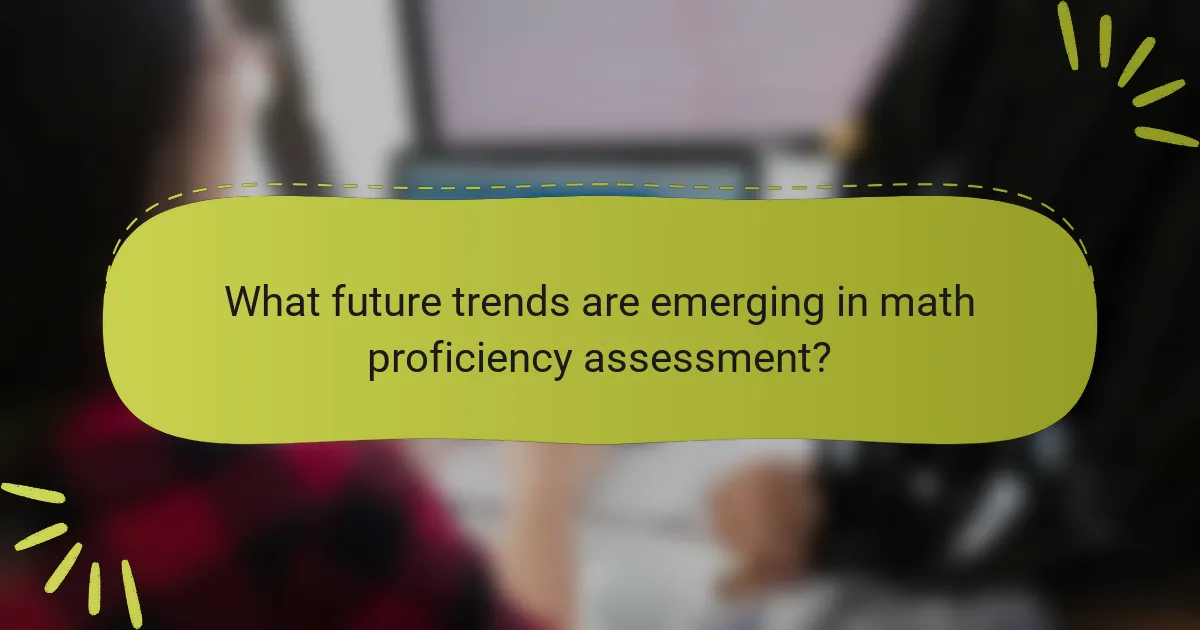
What future trends are emerging in math proficiency assessment?
Future trends in math proficiency assessment include the integration of technology and personalized learning. Adaptive assessments are becoming more prevalent. These assessments adjust difficulty based on student responses. Data analytics is increasingly used to identify learning gaps. This allows for targeted interventions. Additionally, formative assessments are gaining popularity. They provide ongoing feedback rather than just a final score. Gamification is also emerging as a method to engage students. Interactive platforms make learning math more enjoyable. Finally, there is a shift towards assessing problem-solving and critical thinking skills. This reflects the need for real-world application of math concepts.
How is the shift toward personalized learning affecting assessment strategies?
The shift toward personalized learning is significantly changing assessment strategies. Personalized learning emphasizes individual student needs and learning styles. Consequently, assessments are becoming more flexible and adaptive. Traditional standardized tests are being replaced by formative assessments that provide ongoing feedback. These assessments allow educators to tailor instruction based on student progress. Technology plays a crucial role, enabling real-time data collection and analysis. This data helps identify specific areas where students struggle. Research indicates that personalized assessments can lead to improved student engagement and outcomes. For example, studies show that students in personalized learning environments demonstrate higher proficiency in math.
What innovations in assessment technology are on the horizon?
Innovations in assessment technology on the horizon include adaptive learning platforms and artificial intelligence-driven analytics. Adaptive learning platforms personalize assessments based on individual student performance. These platforms adjust question difficulty in real-time to match student proficiency levels. Artificial intelligence-driven analytics provide insights into learning patterns and predict student outcomes. They analyze vast amounts of data to identify at-risk students early. Additionally, gamification elements are being integrated into assessments to enhance engagement and motivation. These innovations aim to create more personalized and effective assessment experiences. Research indicates that such technologies can improve learning outcomes significantly. For example, a study by the Bill & Melinda Gates Foundation found that adaptive assessments can lead to a 30% increase in student performance.
What practical tips can educators use to improve math proficiency assessments?
Educators can improve math proficiency assessments by implementing formative assessments regularly. Formative assessments provide ongoing feedback to students. This allows for adjustments in teaching strategies. Incorporating diverse question types enhances engagement. Multiple-choice, short answer, and problem-solving questions cater to different learning styles. Using real-world applications makes math relevant and relatable. This approach increases student interest and understanding. Additionally, analyzing assessment data helps identify areas for improvement. Tailoring instruction based on data leads to better outcomes. Collaborative learning opportunities can also enhance understanding. Group work encourages discussion and peer support. These practical tips create a more effective assessment environment.
How can collaborative assessment practices enhance student engagement in math?
Collaborative assessment practices enhance student engagement in math by promoting active participation and peer interaction. These practices encourage students to work together, fostering a sense of community. When students collaborate, they share diverse perspectives, which can deepen understanding of mathematical concepts. Research shows that collaborative learning can lead to higher motivation levels. A study by Johnson and Johnson (1999) indicates that cooperative learning increases student achievement and retention. Additionally, collaborative assessments create opportunities for immediate feedback among peers. This feedback loop can boost confidence and encourage risk-taking in problem-solving. Ultimately, these practices transform the learning environment, making math more engaging and relevant for students.
What are effective ways to involve students in the assessment process?
Effective ways to involve students in the assessment process include self-assessment, peer assessment, and collaborative goal-setting. Self-assessment allows students to reflect on their own learning and identify areas for improvement. Peer assessment encourages students to provide feedback to each other, fostering a sense of community and shared responsibility. Collaborative goal-setting involves students in creating their own learning objectives, increasing their investment in the assessment process. Research shows that when students actively participate in assessments, their engagement and motivation improve. For instance, a study by Black and Wiliam (1998) indicates that formative assessment practices enhance student learning outcomes.
Assessment strategies for measuring math proficiency in students encompass formative, summative, and diagnostic assessments, each serving distinct purposes in evaluating student understanding and skills. Formative assessments provide ongoing feedback during instruction, while summative assessments evaluate learning at the end of an instructional period. Diagnostic assessments identify individual strengths and weaknesses prior to instruction. The article emphasizes the importance of aligning these strategies with learning objectives to enhance educational outcomes, and it explores the implications of math proficiency on academic success and future opportunities. Additionally, it discusses the role of technology and data analytics in improving assessment methods and student engagement.
